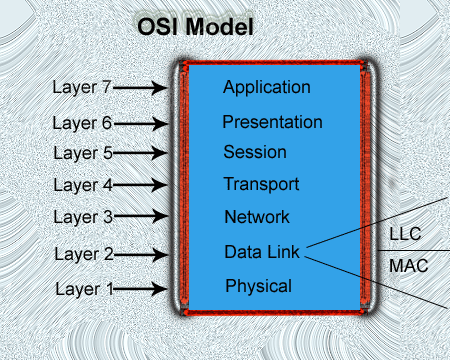- List the layers of OSI?
From top to bottom, OSI layers are,
Application, Presentation, Session, Transport, Network, Data Link and Physical.
- What are the responsibilities of Data Link Layer?
Framing, Error detection, CRC and Physical Addressing is the task of DLL.
- What are the responsibilities of Network Layer?
Routing, IP Addressing and Path determination are the main responsibilities of Network Layer.
- What are the responsibilities of Transport Layer?
Transport Layer has a lot of function. Most important being,
- Multiplexing and De-Multiplexing
- Segmentation and Re-assembly
- Flow Control
- Error Correction
- Connection Establishment
- Sequencing
- Acknowledgement
- 3 way Handshake
- Routers work at which OSI layer?
Network Layer
- Switches work at which OSI layer?
Layer 2 and Some Switches can operate at Layer 3 and above
- What is a Window in networking terms?
Window is the amount of segments sent by TCP between two acknowledgements.
- What is the role of the LLC sublayer in datalink layer?
Logical Link Control provides error detection, using Ethernet trailer field frame check sequence (FCS).
- What is the function of the Application Layer in networking?
Application Layer is responsible for providing a user interface in between user and Network with the help of applications like web browsers.
- What is the difference between TCP and UDP?
Following are differences in TCP and UDP,
- TCP stands for “Transmission Control Protocol” UDP stands for “User datagram Protocol”.
- TCP is connection oriented protocol while UDP is connectionless protocol.
- TCP is more reliable than UDP.
- UDP is faster for data sending than TCP.
- UDP makes error checking but no reporting but TCP checks for errors and performs reporting.
- TCP provides guaranteed Delivery of Data but UDP has no guarantee.
- Header size of TCP is 20 bytes while that of UDP is 8 bytes.
- TCP has acknowledgement segments but UDP has no acknowledgement.
- TCP is used for application that require high reliability but less time critical whereas UDP is used for application that are time sensitive but require less reliability.
- What is the port no of DNS and Telnet?
DNS = 53, Telnet = 23
- Which service use both TCP and UDP ?
DNS uses both TCP and UDP
- What is the port no of SMTP and POP3?
POP3 = 110; SMTP = 25
- In which layer term “Frames” is used ?
Frames are PDU of Data Link Layer
- In which layer term “Packets” is used ?
Packets are PDU of Network Layer
- In which layer term “Segments” is used ?
Segments are used at Transport Layer
- Give some example for protocols work at Application layer ?
Application Layer Protocols are HTTP, HTTPs, Telnet, SSH, DNS, FTP, TFTP, DHCP, RIP
- What is CRC? Which layer CRC works ?
Cyclic Redundancy Check is used to detect the errors in network. It works at Data Link Layer (LLC Sub Layer).
- What is the purpose of the Data Link?
Data Link Layer is responsible for Framing, Error Detection and Physical Addressing
- Which one is reliable – TCP or UDP ?
TCP is reliable.
- What is the port number of ftp (data) and ftp?
FTP port number 20 (Data); 21 for Control
- Which layer provides logical addressing that routers will use for path determination ?
Network Layer
- Which layer specifies voltage, wire speed, and pinout cables and moves bits between devices ?
Physical
- Which layer combines bits into bytes and bytes into frames, uses MAC addressing, and provide error detection ?
Data Link Layer
- Which layer is responsible for keeping the data from different applications separate on the network ?
Session layer.
- Which layer segments and resembles data into a data stream ?
Transport layer.
- Which layer provides the physical transmission sof the data and handless error notification, network topology, and flow control ?
Data Link Layer
- Which Layer manages device addressing, tracks the location of devices on the network, and determine the best way to move data ?
Network layer.
- How Data breaks down on each layer from top to bottom ?
Encapsulation occurs in following format

- MAC address works on which layer ? What are the differences of MAC sublayer and LLC sublayer?
MAC works at DATA LINK LAYER. Media Access Control provides physical addressing while Logical Link Control provides error detection, using Ethernet trailer field frame check sequence (FCS). It is 4 bytes field. When a sending device sends a data it put the data in a mathematical algorithm and it gets a product, sending device puts the product in FCS. When a receiving device receive a data it also put the data in same mathematical algorithm and get a product. If both products are same, Frame is accepted or else discarded.
- Which layer is responsible for converting data packets from the Data Link layer into electrical signals ?
Physical Layer
- At which layer is routing implemented, enabling connections and path selection between two end systems. ?
Network Layer
- Which layer defines how data is formatted, presented, encoded,and converted for use on the network ?
Presentation Layer
- Which layer is responsible for creating, managing and terminating sessions between applications ?
Session Layer
- DNS uses which protocol? Why?
DNS uses both TCP and UDP
- Which layer is closer to the user?
From sender point of view, Application Layer is closest and from Receiver point of view Pgysical Layer is closest.
- Differentiate between forward lookup and reverse lookup in DNS?
Forward Lookup: Name to IP resolution
Reverse Lookup: IP to Name resolution;
- What is IPSec?
IPSec provides data security at the IP Packet Level.
- What is the way to establish a TCP connection?
TCP Connection is established using three-way Handshake.
- What is the difference between flow control and error control?
Error Controls the process of detecting and correcting both the bit and packet level error. While flow control is a mechanism to ensure the efficient delivery of Data. Flow control is agreeing on the minimum amount of data that a receiver can handle at a time.



.png)


